Evaluation and Projection of Extreme Precipitation over Northern China in CMIP5 Models
Abstract
1. Introduction
2. Experiments
2.1. Observation Data and CMIP5 Simulations
2.2. Extreme Rainfall Indices
2.3. Analysis Methods
3. Evaluation of Models
3.1. Spatial Distribution
3.2. Interannual Variability
3.3. Optimal Models
4. Projected Future Changes in Precipitation Extremes
4.1. Spatial Patterns
4.2. Uncertainties of Projections
4.3. Temporal Evolution
4.4. Possible Causes
5. Discussion and Conclusions
Author Contributions
Funding
Acknowledgments
Conflicts of Interest
References
- Field, C.B.; Barros, V.; Stocker, T.F.; Dahe, Q. (Eds.) Managing the Risks of Extreme Events and Disasters to Advance Climate Change Adaptation; Cambridge University Press: Cambridge, UK, 2012; 582p. [Google Scholar]
- IPCC. Climate Change 2013: The Physical Science Basis; Stocker, T.F., Qin, D., Nauels, A., Xia, Y., Bex, V., Midgley, P.M., Plattner, G.K., Tignor, M.M.B., Allen, S.K., Boschung, J., Eds.; Contribution of Working Group I to the Fifth Assessment Report of the Intergovernmental Panel on Climate Change; Cambridge University Press: Cambridge, UK; New York, NY, USA, 2013; 1029p. [Google Scholar]
- Stocker, T.F.; Qin, D.; Plattner, G.-K.; Tignor, M.; Allen, S.K.; Boschung, J.; Nauels, A.; Xia, Y.; Bex, V.; Midgley, P.M.; et al. (Eds.) Climate Change 2013: The Physical Science Basis; Cambridge University Press: Cambridge, UK, 2013; 1535p. [Google Scholar]
- Pierce, D.W.; Barnett, T.P.; Santer, B.D.; Gleckler, P.J. Selecting global climate models for regional climate change studies. Proc. Natl. Acad. Sci. USA 2009, 106, 8441–8446. [Google Scholar] [CrossRef] [PubMed]
- Sperber, K.R.; Annamalai, H.; Kang, I.-S.; Kitoh, A.; Moise, A.; Turner, A.; Wang, B.; Zhou, T. The Asian summer monsoon: An intercomparison of CMIP5 vs. CMIP3 simulations of the late 20th century. Clim. Dyn. 2012, 41, 2711–2744. [Google Scholar] [CrossRef]
- Wuebbles, D.; Meehl, G.; Hayhoe, K.; Karl, T.R.; Kunkel, K.; Santer, B.; Wehner, M.; Colle, B.; Fischer, E.M.; Fu, R.; et al. CMIP5 climate model analyses: Climate extremes in the United States. Bull. Am. Meteorol. Soc. 2014, 95, 571–583. [Google Scholar] [CrossRef]
- Yu, E.T.; Xiang, W.L. Projected Climate Change in the Northwestern Arid Regions of China: An Ensemble of Regional Climate Model Simulations. Atmos. Ocean. Sci. Lett. 2015, 8, 131–142. [Google Scholar]
- Xia, L.; Zhou, Y. Tracking Jianghuai cyclones in China and their climate characteristics. Atmosphere 2018, 9, 341. [Google Scholar] [CrossRef]
- Gao, X.J.; Zhao, Z.C.; Giorgi, F. Changes of extreme events in regional climate simulations over east Asia. Adv. Atmos. Sci. 2002, 19, 927–942. [Google Scholar]
- Chen, W.L.; Jiang, Z.; Li, L. Probabilistic projections of climate change over China under the SRES A1B scenario using 28 AOGCMs. J. Clim. 2011, 24, 4741–4756. [Google Scholar] [CrossRef]
- Wang, H.-J.; Sun, J.-Q.; Chen, H.-P.; Zhu, Y.-L.; Zhang, Y.; Jiang, D.-B.; Lang, X.-M.; Fan, K.; Yu, E.-T.; Yang, S. Extreme Climate in China: Facts, Simulation and Projection. Meteorol. Z. 2012, 21, 279–304. [Google Scholar] [CrossRef]
- Ou, T.; Chen, D.; Linderholm, H.; Jeong, J.-H. Evaluation of global climate models in simulating extreme precipitation in China. Tellus A Dyn. Meteorol. Oceanogr. 2013, 65. [Google Scholar] [CrossRef]
- Zhou, B.; Wen, Q.H.; Xu, Y.; Song, L.; Zhang, X. Projected Changes in Temperature and Precipitation Extremes in China by the CMIP5 Multimodel Ensembles. J. Clim. 2014, 27, 6591–6610. [Google Scholar] [CrossRef]
- Di, T.; Yan, G.; Dong, W.J. Future changes and uncertainties in temperature and precipitation over China on CMIP5 models. Adv. Atmos. Sci. 2015, 32, 487–496. [Google Scholar]
- Xu, Y.; Gao, X.; Giorgi, F.; Zhou, B.; Shi, Y.; Wu, J.; Zhang, Y. Projected changes in temperature and precipitation extremes over China as measured by 50-yr return values and periods based on a CMIP5 ensemble. Adv. Atmos. Sci. 2018, 35, 376–388. [Google Scholar] [CrossRef]
- Chen, H.P. Projected change in extreme rainfall events in China by the end of the 21st century using CMIP5 models. Chin. Sci. Bull. 2013, 58, 1462–1472. [Google Scholar] [CrossRef]
- Palmer, T.N.; Doblas-Reyes, F.J.; Hagedorn, R.; Weisheimer, A. Probabilistic prediction of climate using muti-model ensembles: From basics to applications. Philos. Trans. R. Soc. B 2005, 360, 1991–1998. [Google Scholar] [CrossRef] [PubMed][Green Version]
- Thomson, M.C.; Doblas-Reyes, F.J.; Mason, S.J.; Hagedorn, R.; Connor, S.J.; Phindela, T.; Morse, A.P.; Palmer, T.N. Malaria early warnings based on seasonal climate forecasts from multi-model ensembles. Nature 2006, 439, 576–579. [Google Scholar] [CrossRef] [PubMed]
- Sun, Y.; Ding, Y.H. An assessment on the performance of IPCC AR4 climate models in simulating interdecadal variations of the East Asian summer monsoon. Acta Meteor. Sin. 2008, 22, 427–488. [Google Scholar]
- Knutti, R. The end of model democracy? An editorial comment. Clim. Chang. 2010, 102, 395–404. [Google Scholar] [CrossRef]
- Seo, K.H.; Ok, J. Assessing future changes in the East Asian summer monsoon using CMIP3 models: Results from the best model ensemble. J. Clim. 2013, 26, 1807–1817. [Google Scholar] [CrossRef]
- Sillmann, J.; Kharin, V.V.; Zhang, X.; Zwiers, F.W.; Bronaugh, D. Climate extremes indices in the CMIP5 multimodel ensemble: Part Model evaluation in the present climate. J. Geophys. Res. 2013, 118, 1716–1733. [Google Scholar] [CrossRef]
- Sillmann, J.V.; Kharin, V.; Zhang, X.W.; Zwiers, F.; Bronaugh, D. Climate extremes indices in the CMIP5 multimodel ensemble: Part Future climate projections. J. Geophys. Res. 2013, 118, 2473–2493. [Google Scholar] [CrossRef]
- Yu, E.T.; Sun, J.Q.; Chen, H.P.; Xiang, W.L. Evaluation of a high-resolution historical simulation over China: Climatology and extremes. Clim. Dyn. 2014, 45, 2013–2031. [Google Scholar] [CrossRef]
- Jiang, Z.H.; Li, W. Extreme precipitation indices over China in CMIP5 models. J. Clim. 2015, 28, 8603–8619. [Google Scholar] [CrossRef]
- Tebaldi, C.; Hayhoe, K.; Arblaster, J.M.; Meehl, G.A. Going to the extremes: An intercomparison of model-simulated historical and future changes in extreme events. Clim. Chang. 2006, 79, 185–211. [Google Scholar] [CrossRef]
- Zhang, X.B.; Alexander, L.; Hegerl, G.C.; Jones, P.; Tank, A.K.; Perterson, T.C.; Trewin, B.; Zwiers, F.W. Indices for monitoring changes in extremes based on daily temperature and precipitation data. Wiley Interdiscip. Rev. Clim. Chang. 2011, 2, 851–870. [Google Scholar] [CrossRef]
- Wu, J.; Gao, X.J. A gridded daily observation dataset over China region and comparison with the other datasets. Chin. J. Geophys. 2013, 56, 1102–1111. [Google Scholar]
- Xu, Y.; Gao, X.J.; Luo, Y. Projected changes in temperature and precipitation extremes over the Yangtze River Basin of China in the 21th century. Quat. Int. 2009, 208, 44–52. [Google Scholar] [CrossRef]
- Klein Tank, A.M.G.; Konnen, G.P. Trends in indices of daily temperature and precipitation extremes in Europe 1964–1999. J. Clim. 2003, 16, 3665–3680. [Google Scholar] [CrossRef]
- Alexander, L.V.; Zhang, X.; Peterson, T.C.; Caesar, J.; Gleason, B.; Tank, A.M.G.K.; Haylock, M.; Collins, D.; Trewin, B.; Rahimzadeh, F.; et al. Global observed changes in daily climate extremes of temperature and precipitation. J. Geophys. Res. 2006, 111, 1–22. [Google Scholar] [CrossRef]
- Nie, H.; Qin, T.; Yang, H.; Chen, J.; He, S.; Lv, Z.; Shen, Z. Trend Analysis of Temperature and Precipitation Extremes during Winter Wheat Growth Period in the Major Winter Wheat Planting Area of China. Atmosphere 2019, 10, 240. [Google Scholar] [CrossRef]
- Taylor, K.E. Summarizing multiple aspects of model performance in a single diagram. J. Geophys. Res. 2001, 106, 7183–7192. [Google Scholar] [CrossRef]
- Gleckler, P.J.; Taylor, K.E.; Doutriaux, C. Performance metrics for climate models. J. Geophys. Res. 2008, 113, D06104. [Google Scholar] [CrossRef]
- Santer, B.D.; Taylor, K.E.; Gleckler, P.J.; Bonfils, C.; Barnett, T.P.; Pierce, D.W.; Wigley, T.M.L.; Mears, C.; Wentz, F.J.; Brüggemann, W.; et al. Incorporating model quality information in climate change detection and attribution studies. Proc. Natl. Acad. Sci. USA 2009, 106, 14778–14783. [Google Scholar] [CrossRef] [PubMed]
- Schuenemann, K.C.; Cassano, J.J. Changes in synoptic weather patterns and Greenland precipitation in the 20th and 21st centuries: Evaluation of late 20th century simulations from IPCC models. J. Geophys. Res. 2009, 114. [Google Scholar] [CrossRef]
- Hawkins, E.; Sutton, R. The potential to narrow uncertainty in projections of regional precipitation change. Clim. Dyn. 2011, 37, 407–418. [Google Scholar] [CrossRef]
- Kim, J.; Park, S.K. Uncertainties in calculating precipitation climatology in East Asia. Hydrol. Earth. Syst. Sci. 2016, 20, 651–658. [Google Scholar] [CrossRef]
- Kim, I.W.; Oh, J.; Woo, S.; Kripalani, R.H. Evaluation of precipitation extremes over the Asia domain: Observation and modelling studies. Clim. Dyn. 2019, 52, 1317–1342. [Google Scholar] [CrossRef]
- Zhang, Y.; Xu, Y.L.; Dong, W.J.; Cao, L.J.; Sparrow, M. A future climate scenario of regional changes in extreme climate events over China using the PRECIS climate model. Geophys. Res. Lett. 2006, 33. [Google Scholar] [CrossRef]
- Gao, X.J.; Shi, Y.; Song, R.Y.; Giorgi, F.; Wang, Y.G.; Zhang, D.F. Reduction of future monsoon precipitation over China: Comparison between a high resolution RCM simulation and the driving GCM. Meteorol. Atmos. Phys. 2008, 100, 73–86. [Google Scholar] [CrossRef]
- Xu, J.Y.; Shi, Y.; Gao, X.J.; Giorgi, F. Projected changes in climate extremes over China in the 21st century from a high resolution regional climate model (RegCM3). Chin. Sci. Bull. 2013, 58, 1443–1452. [Google Scholar] [CrossRef]
- Lee, J.W.; Hong, S.Y.; Chang, E.C.; Suh, M.S.; Kang, H.S. Assessment of future climate change over East Asia due to the RCP scenarios downscaled by GRIMs-RMP. Clim. Dyn. 2014, 42, 733–747. [Google Scholar] [CrossRef]
- Li, W.; Jiang, Z.H.; Xu, J.J.; Li, L. Extreme precipitation Indices over China in CMIP5 Models. Part II: Probabilistic Projection. J. Clim. 2016, 29, 8989–9004. [Google Scholar] [CrossRef]
- You, Q.; Kang, S.; Aguilar, E.; Pepin, N.; Flügel, W.A.; Yan, Y.; Xu, Y.; Zhang, Y.; Huang, J. Changes in daily climate extremes in China and their connection to the large scale atmospheric circulation during 1961–2003. Clim. Dyn. 2011, 36, 2399–2417. [Google Scholar] [CrossRef]
- Zhang, Q.; Xu, C.; Zhang, Z.; Chen, Y.D.; Liu, C.; Lin, H. Spatial and temporal variability of precipitation maxima during 1960–2005 in the Yangtze River basin and possible association with large-scale circulation. J. Hydrol. 2008, 353, 215–227. [Google Scholar] [CrossRef]
- Gao, X.J.; Shi, Y.; Filippo, G. Comparison of convective parameterizations in RegCM4 experiments over China with CLM as the land surface model. Atmos. Ocean. Sci. Lett. 2016, 9, 246–254. [Google Scholar] [CrossRef]
- Gao, X.-J.; Wu, J.; Shi, Y.; Wu, J.; Han, Z.-Y.; Zhang, D.-F.; Tong, Y.; Li, R.-K.; Xu, Y.; Giorgi, F. Future changes in thermal comfort conditions over China based on multi-RegCM4 simulations. Atmos. Ocean. Sci. Lett. 2018, 11, 291–299. [Google Scholar] [CrossRef]
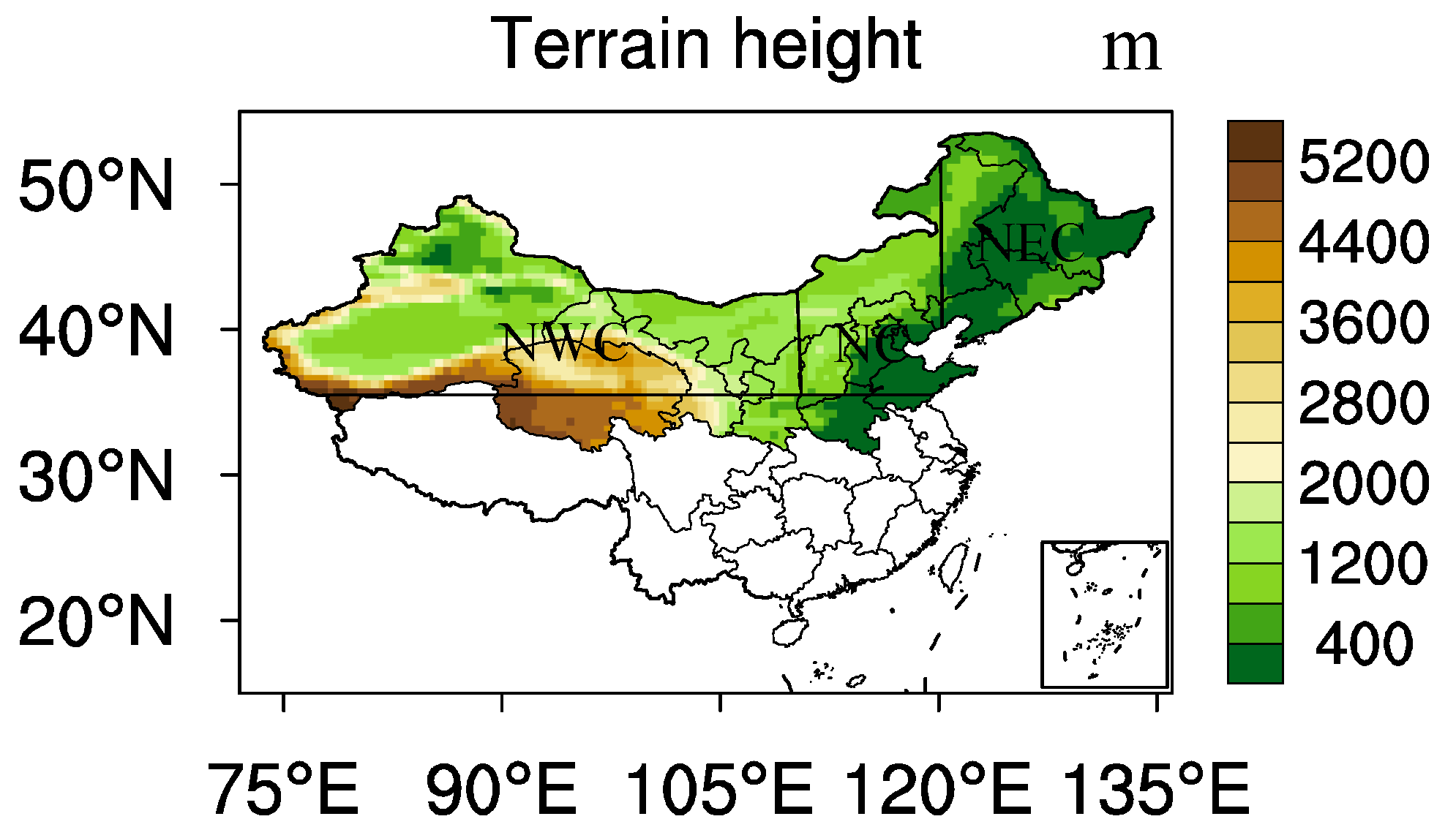
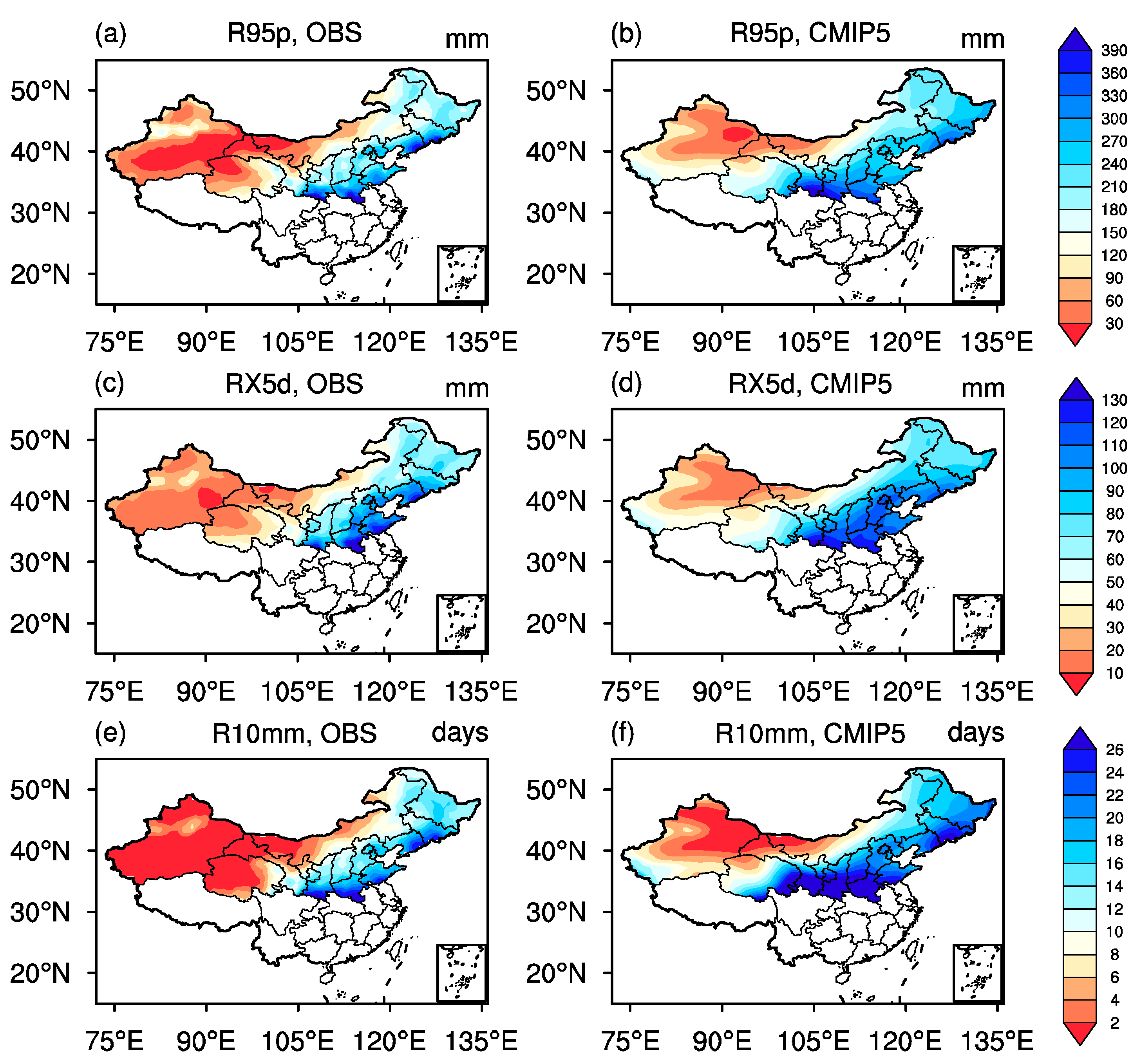
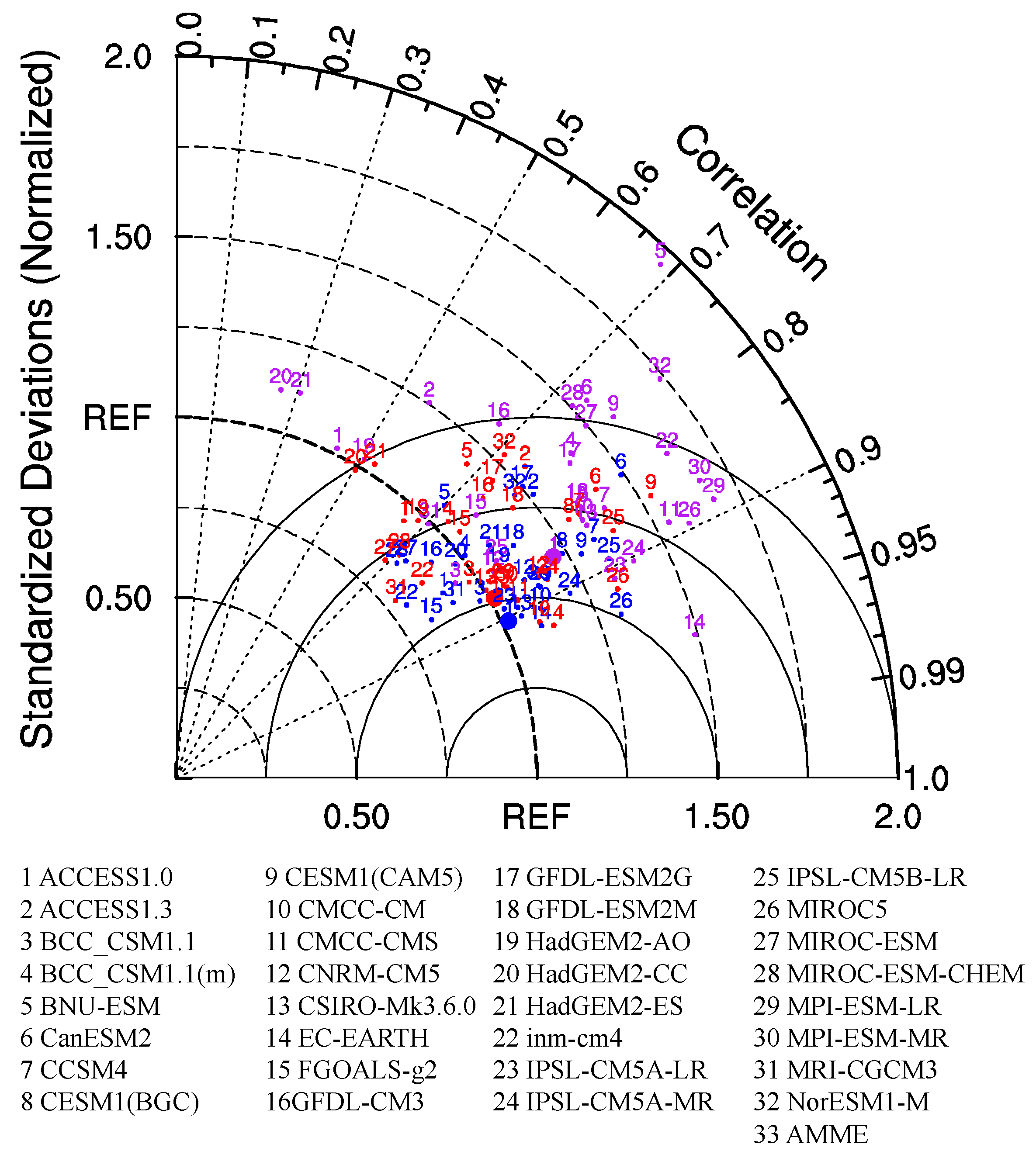
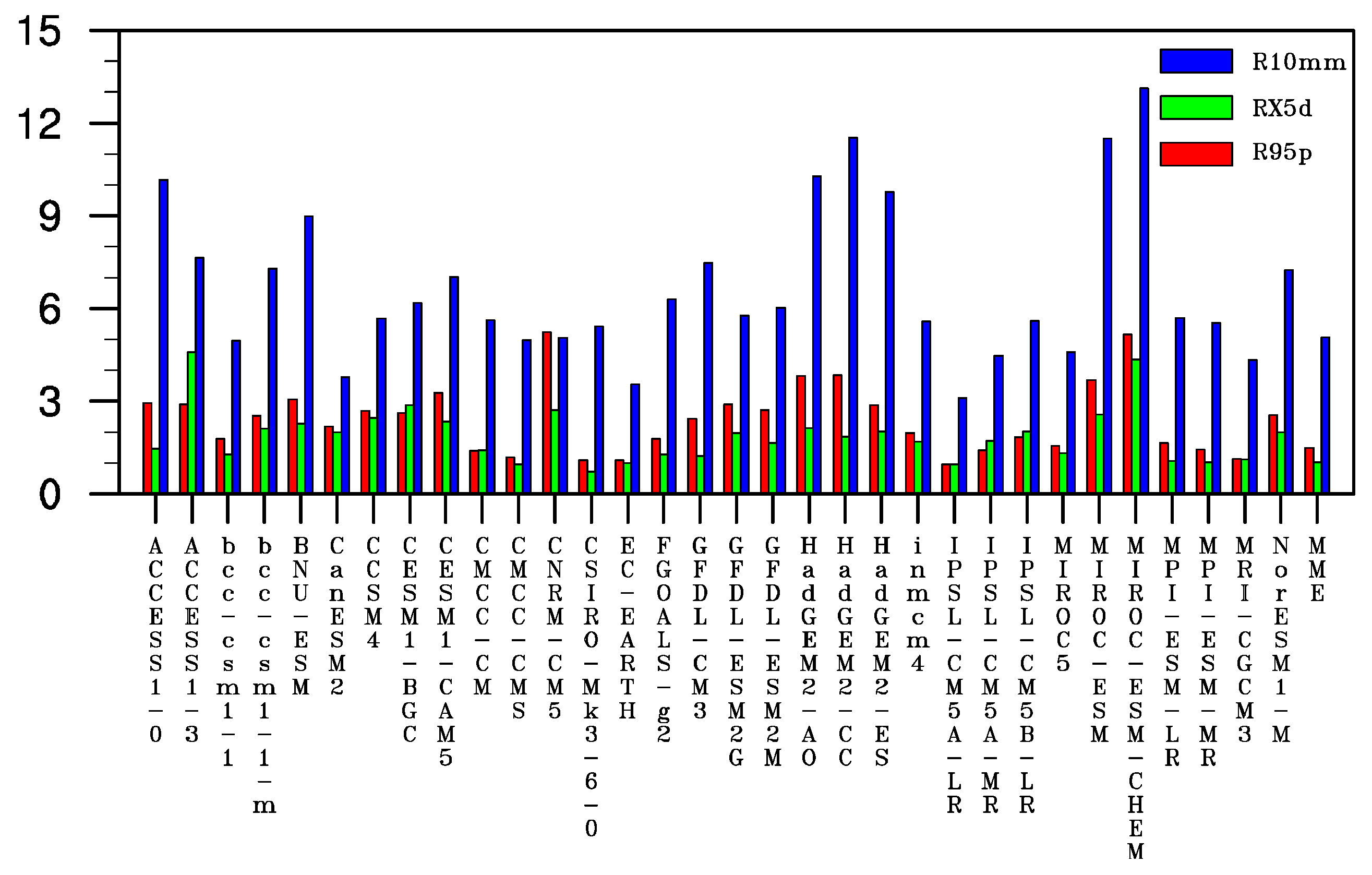
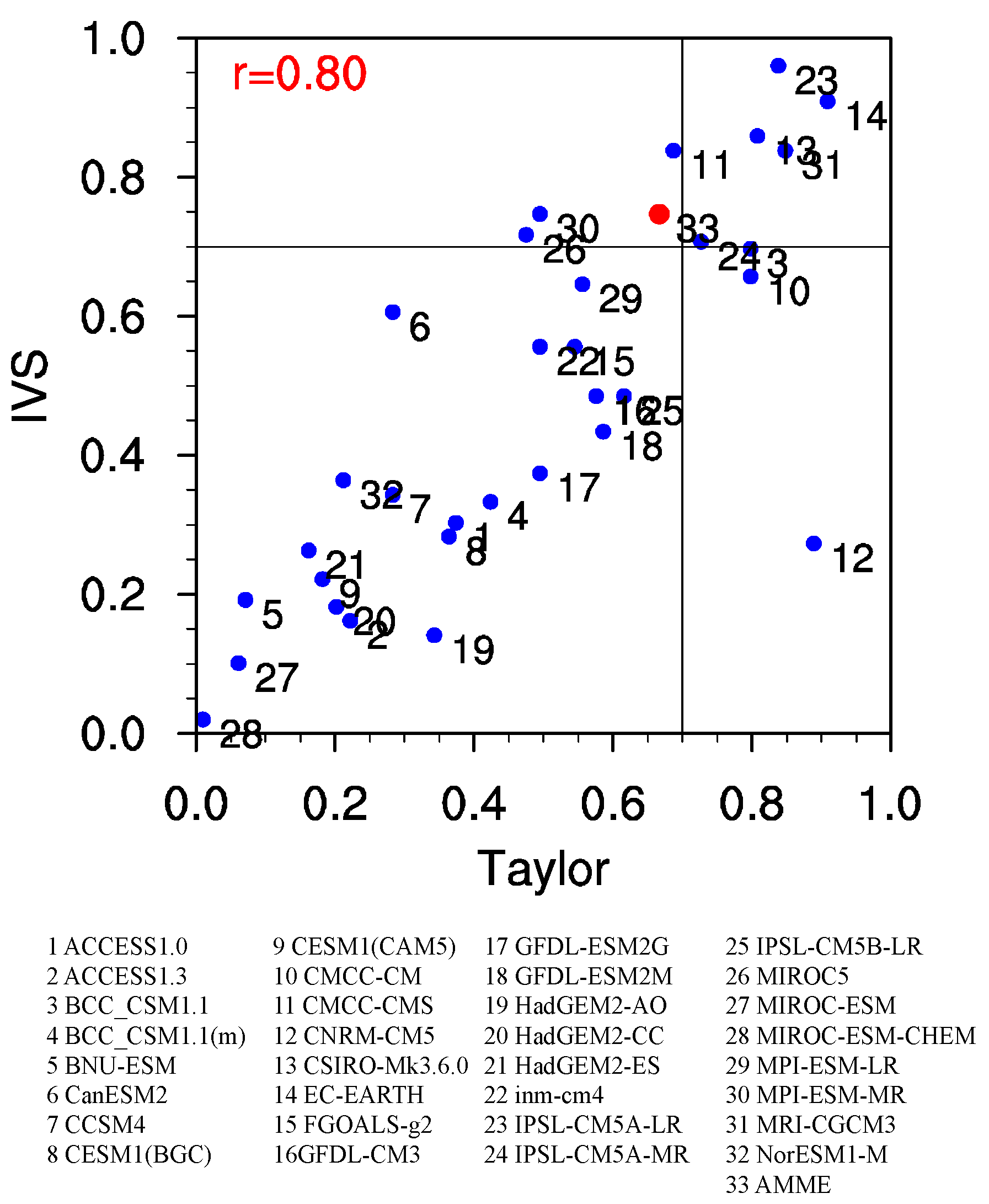
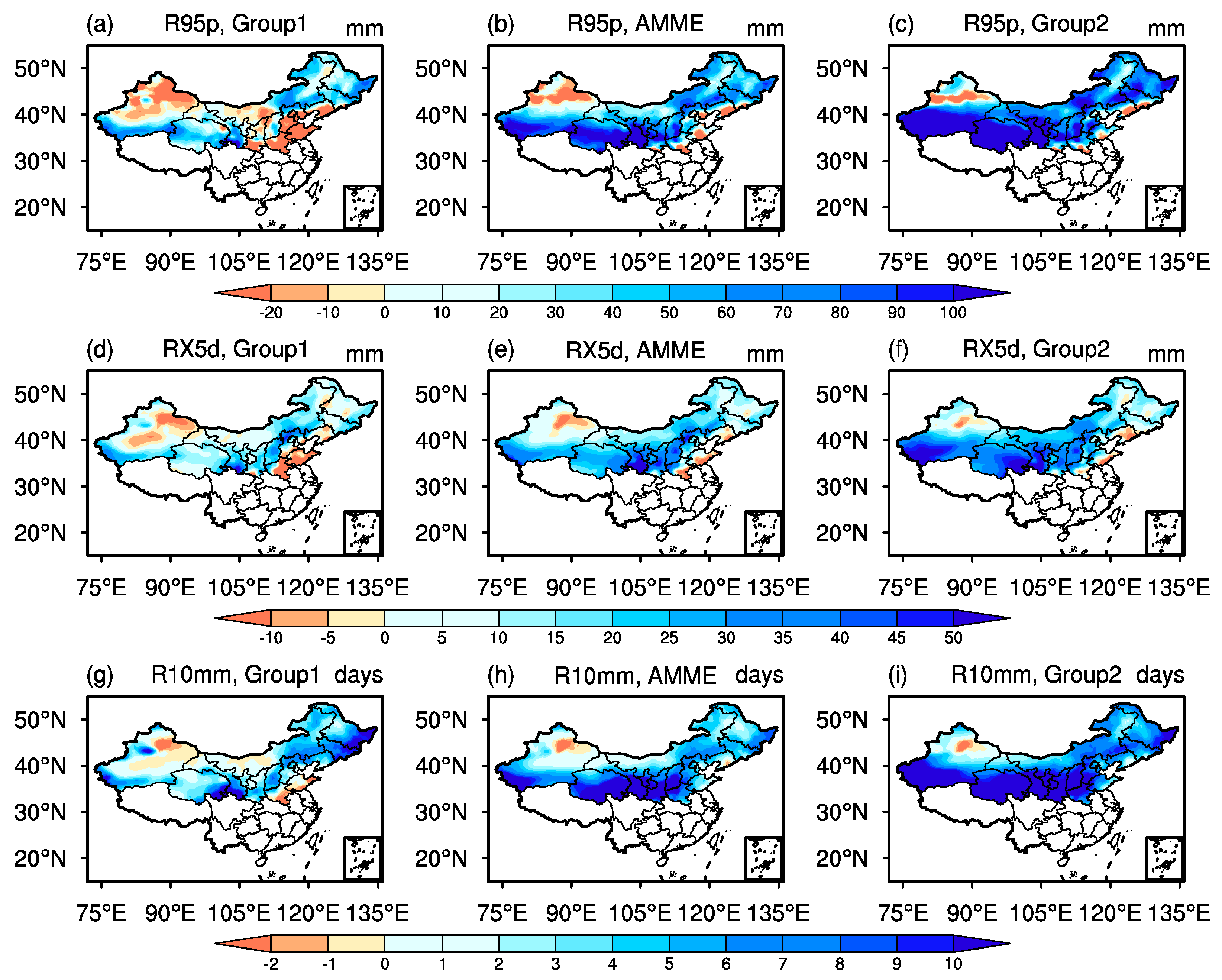
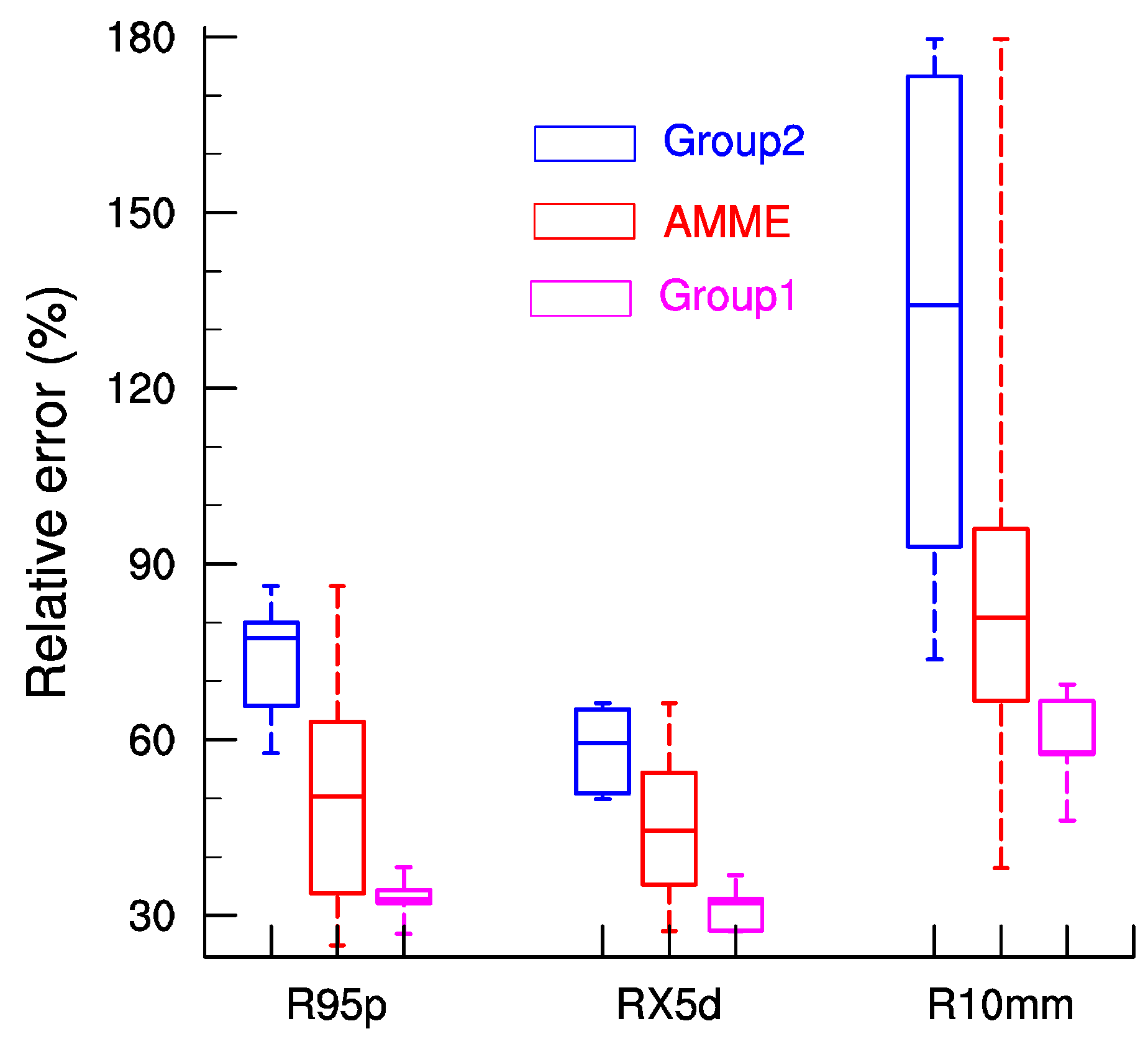
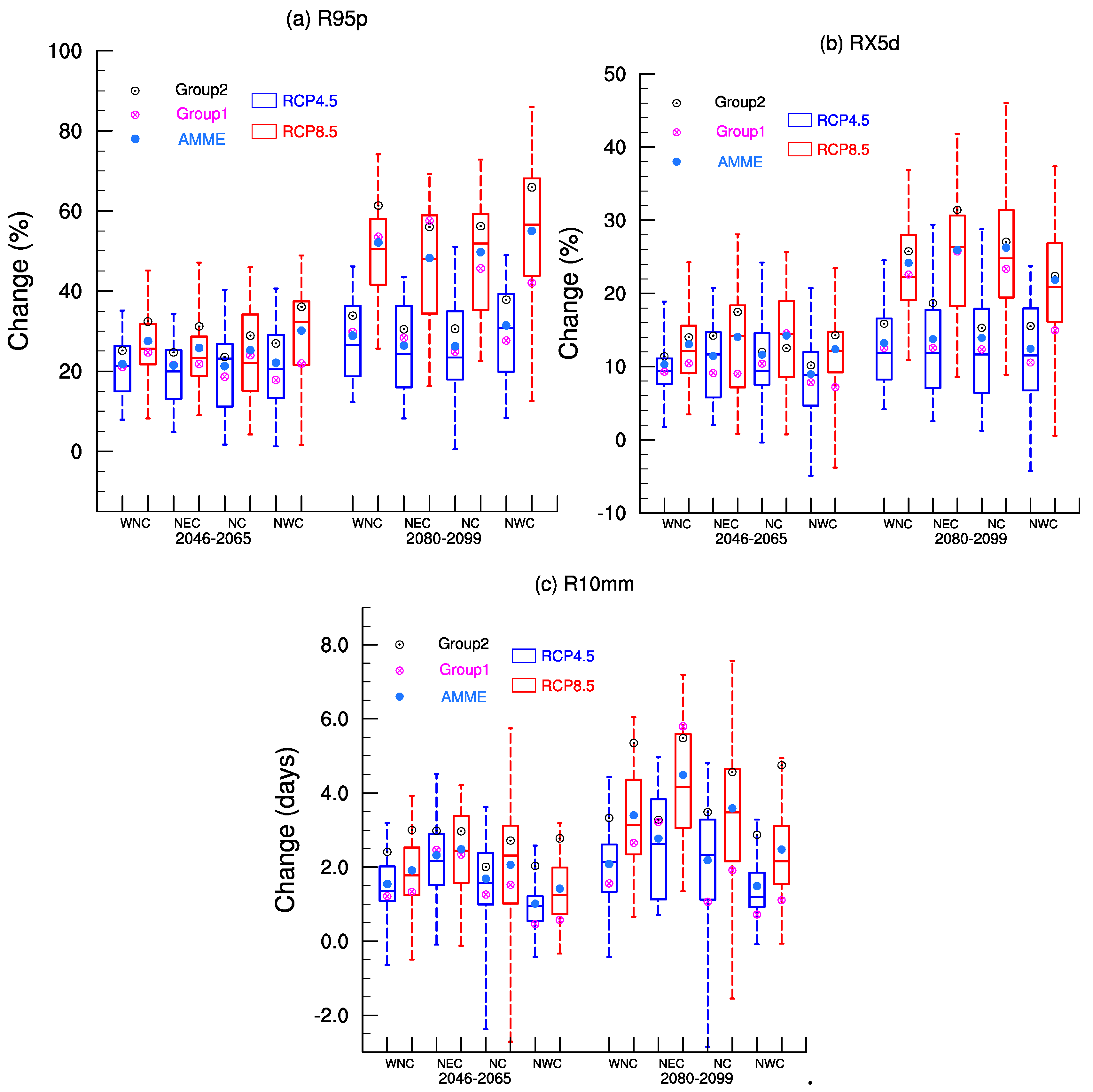
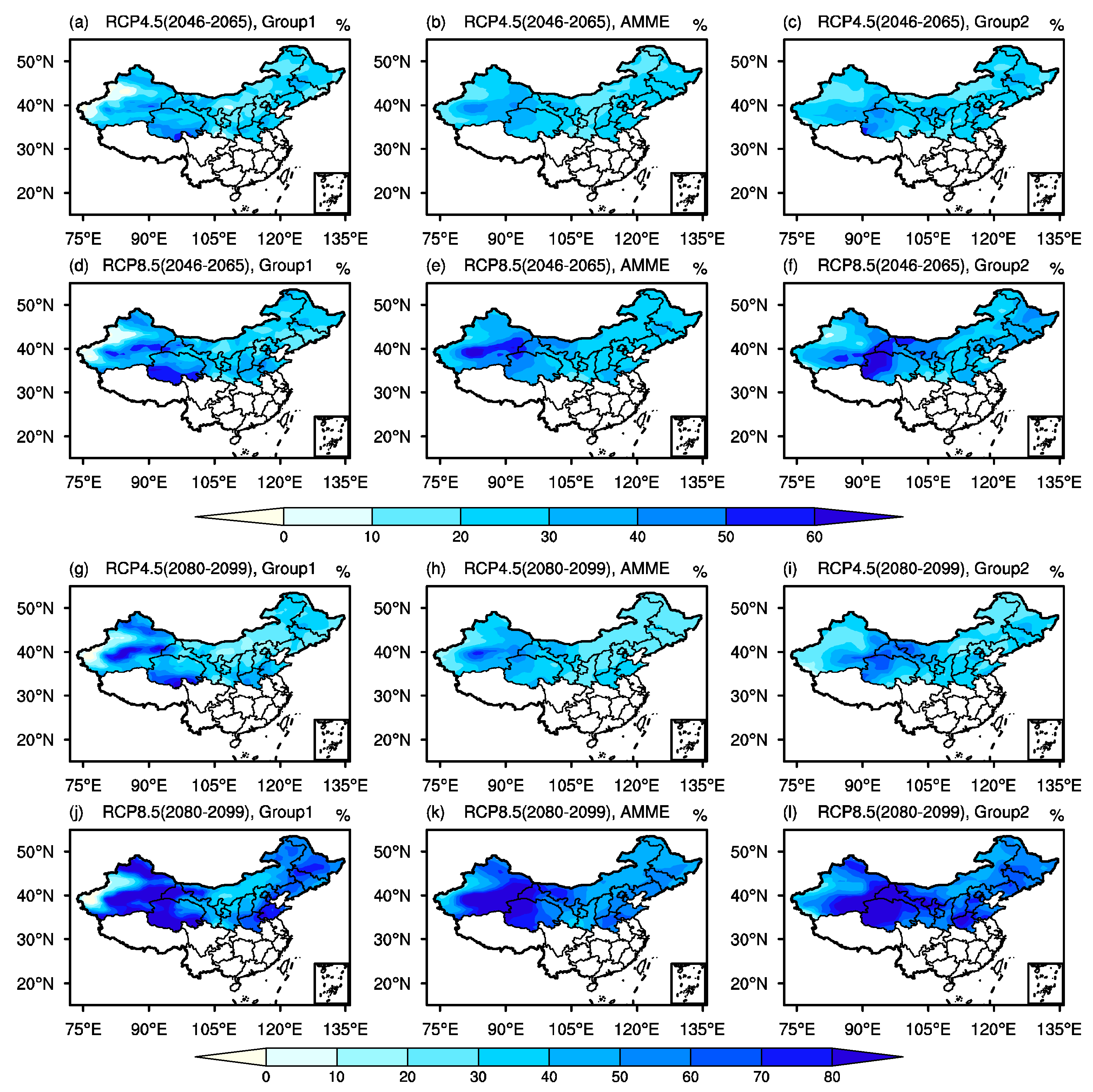

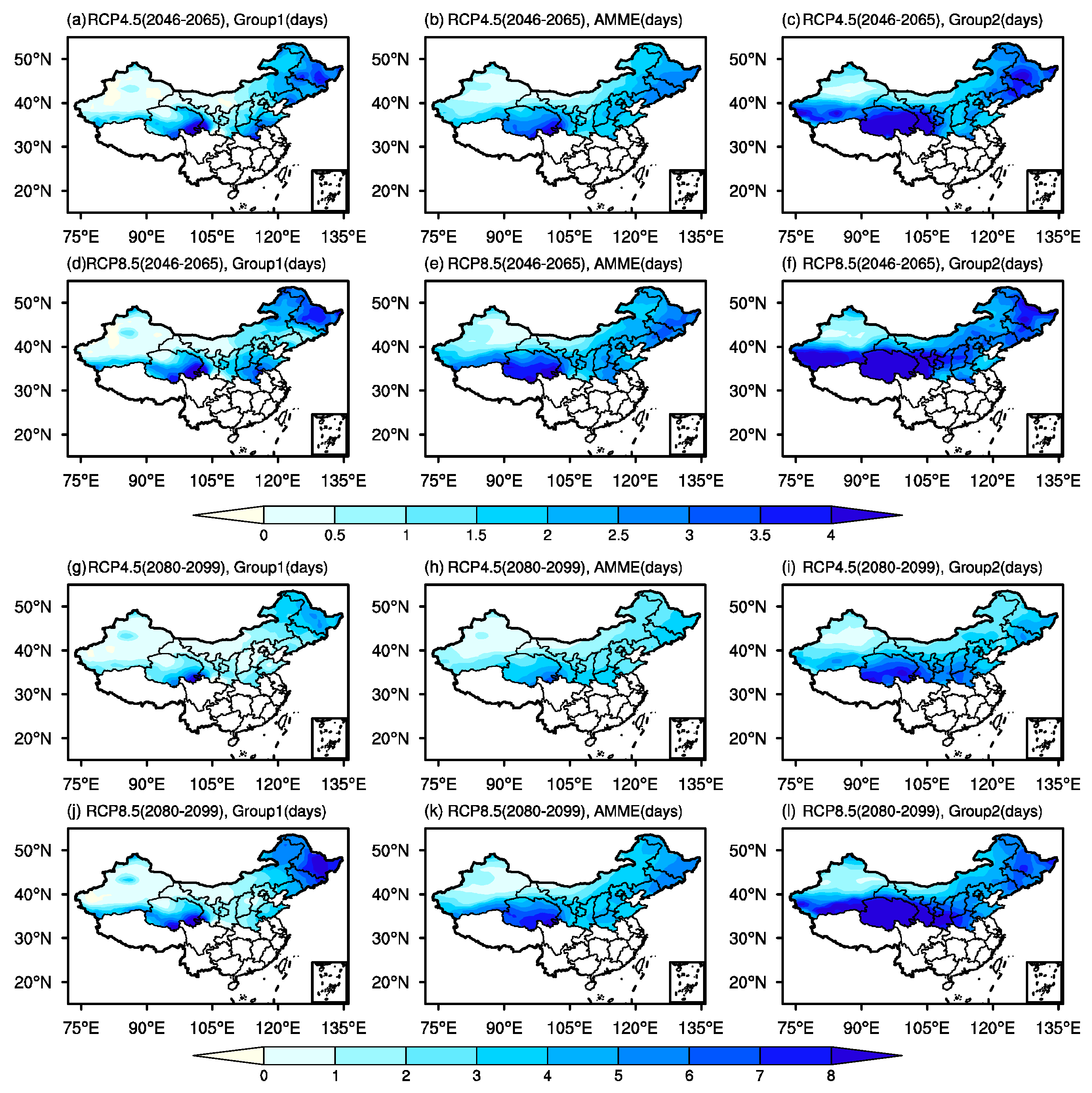
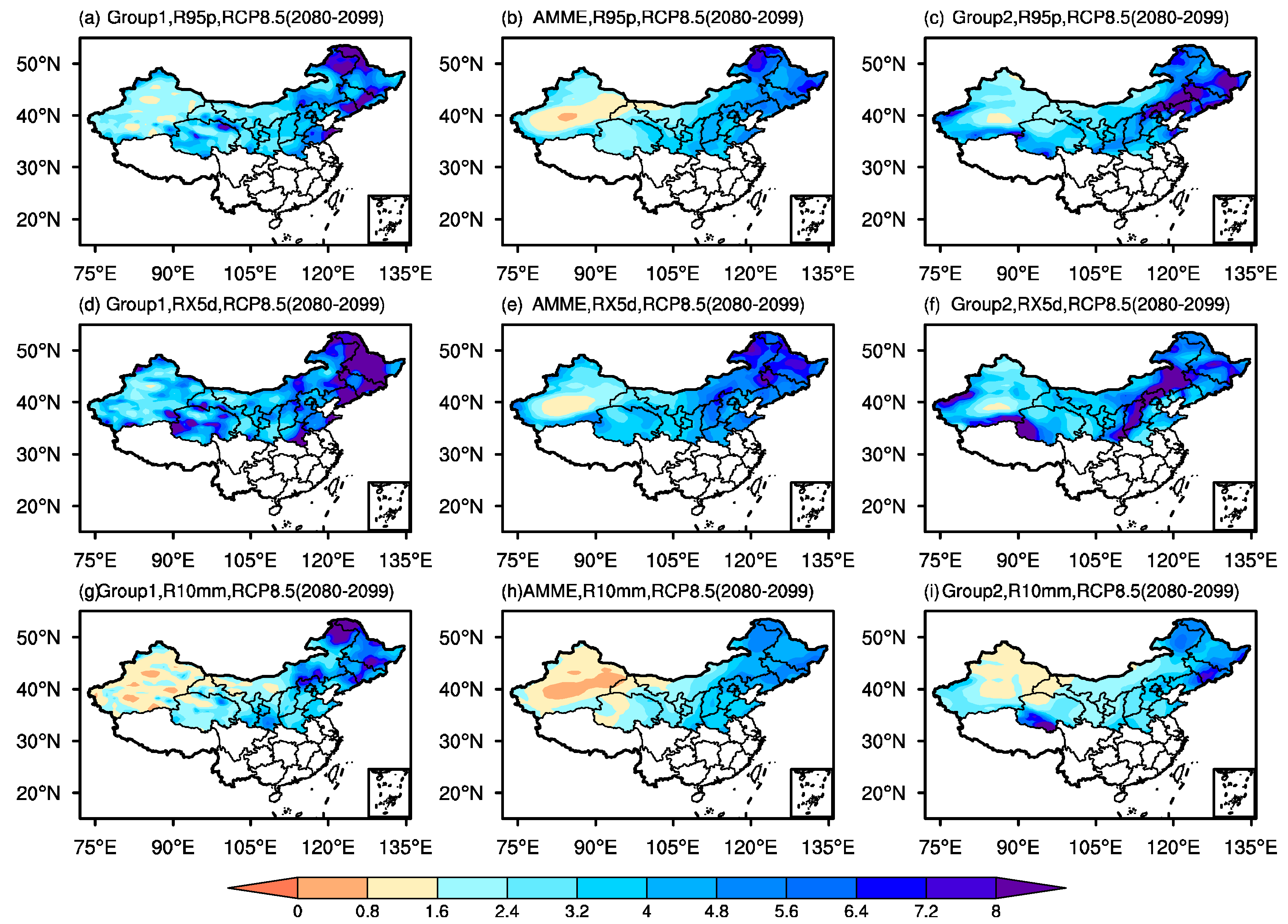
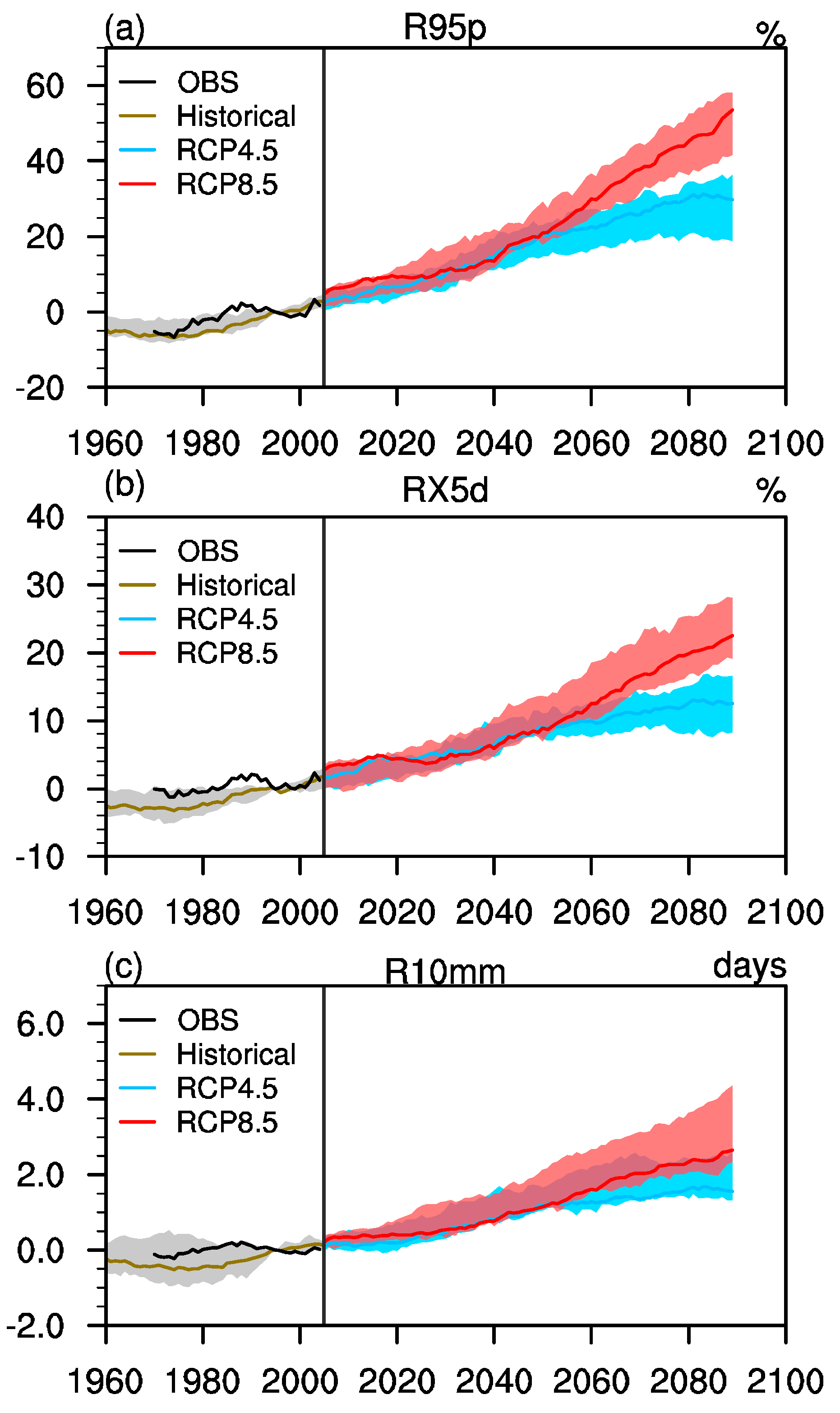
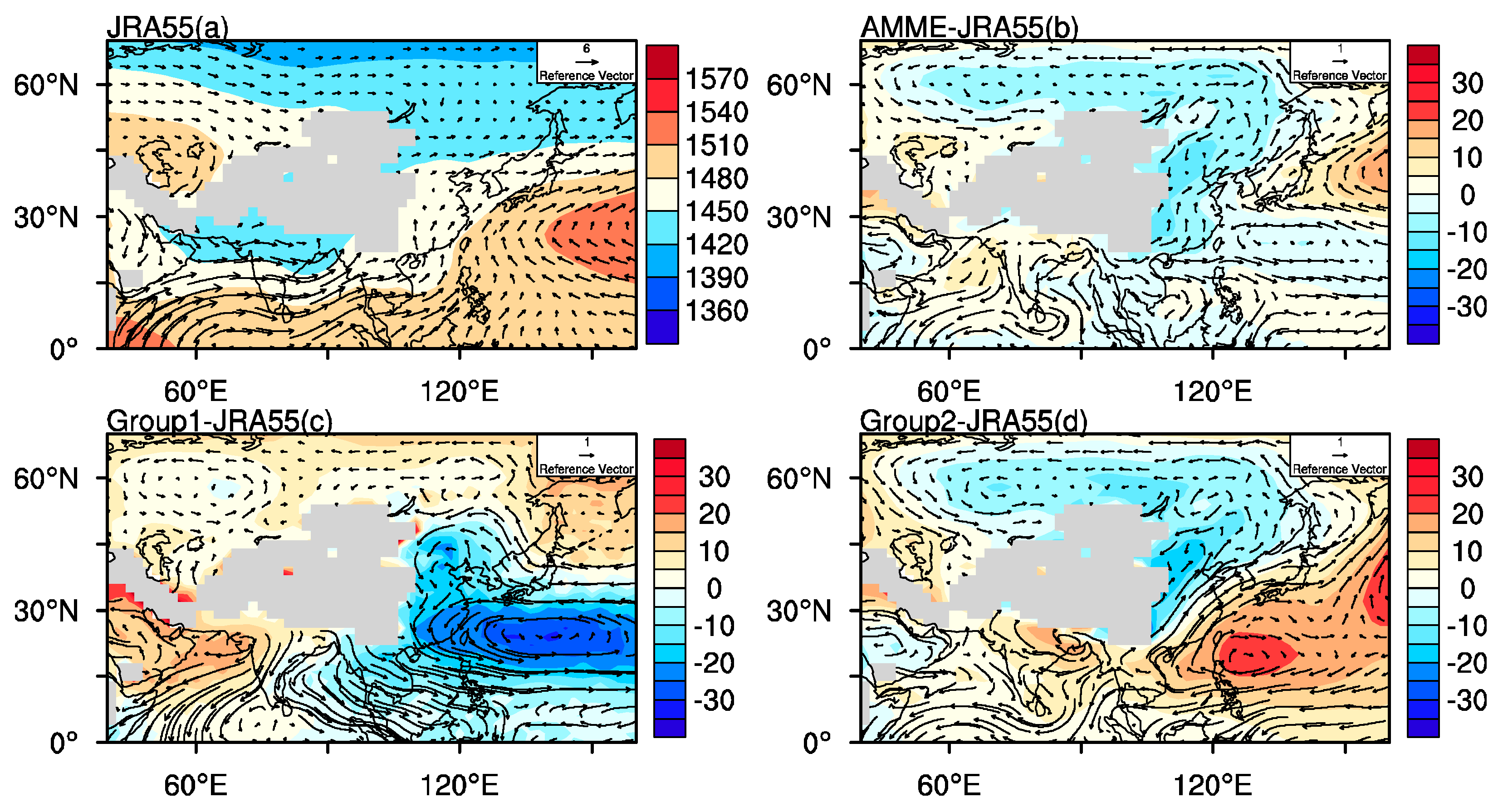
| No. | Model Name | Institution Name and Country | Atmospheric Resolution |
|---|---|---|---|
| 1 | ACCESS1.0 | Commonwealth Scientific and Industrial Research Organization (CSIRO), and Bureau of Meteorology (BoM), Australia | 1.875° × 1.25° |
| 2 | ACCESS1.3 | CSIRO and BoM, Australia | 1.875° × 1.25° |
| 3 | BCC_CSM1.1 | Beijing Climate Center (BCC), China Meteorological Administration (CMA), China | 2.8125° × 2.8125° |
| 4 | BCC_CSM1.1 (m) | BCC and CMA, China | 1.125° × 1.12° |
| 5 | BNU-ESM | College of Global Change and Earth System Science, Beijing Normal University (GCESS), China | 2.8° × 2.8° |
| 6 | CanESM2 | Canadian Center for Climate Modelling and Analysis (CCCma), Canada | 2.8° × 2.8° |
| 7 | CCSM4 | National Center for Atmospheric Research (NCAR), USA | 1.25° × 0.94° |
| 8 | CESM1(BGC) | National Science Foundation (NSF), Department of Energy (DOE), National Center for Atmospheric Research (NCAR), USA | 1.25° × 0.94° |
| 9 | CESM1 (CAM5) | NSF-DOE-NCAR, USA | 1.25° × 0.94° |
| 10 | CMCC-CM | Centro Euro-Mediterraneo per I Cambiamenti Climatici (CMCC), Italy | 0.75° × 0.75° |
| 11 | CMCC-CMS | CMCC | 1.875° × 1.875° |
| 12 | CNRM-CM5 | Centre National de Recherches Météorologiques–Centre Européen de Recherche et de Formation Avancée en Calcul Scientifique (CNRM–CERFACS), France | 1.4° × 1.4 |
| 13 | CSIRO-Mk3.6.0 | CSIRO Marine and Atmospheric Research (Melbourne) in collaboration with the Queensland Climate Change Centre of Excellence (QCCCE) (Brisbane), Australia | 1.875° × 1.875° |
| 14 | EC-EARTH | EC-EARTH consortium | 1.125° × 1.125° |
| 15 | FGOALS-g2 | LASG, Institute of Atmospheric Physics, Chinese Academy of Sciences and Center for Earth System Science (CESS), Tsinghua University, China | 2.8° × 3° |
| 16 | GFDL-CM3 | NOAA/Geophysical Fluid Dynamics Laboratory (GFDL), USA | 2.5° × 2.0° |
| 17 | GFDL-ESM2G | NOAA/GFDL, USA | 2.5° × 2.0° |
| 18 | GFDL-ESM2M | NOAA/GFDL, USA | 2.5° × 2.0° |
| 19 | HadGEM2-AO | National Institute of Meteorological Research (NIMR)/Korea Meteorological Administration (KMA), Korea and United Kingdom | 1.875° × 1.25° |
| 20 | HadGEM2-CC | Met Office Hadley Centre (MOHC), United Kingdom | 1.875° × 1.25° |
| 21 | HadGEM2-ES | MOHC, United Kingdom | 1.875° × 1.25° |
| 22 | INM-CM4 | Institute for Numerical Mathematics (INM), Russia | 2.0° × 1.5° |
| 23 | IPSL-CM5A-LR | Institute Pierre-Simon Laplace (IPSL), France | 3.75° × 1.875° |
| 24 | IPSL-CM5A-MR | IPSL, France | 2.5° × 1.27° |
| 25 | IPSL-CM5B-LR | IPSL, France | 3.75° × 1.875° |
| 26 | MIROC5 | The University of Tokyo (MIROC), Japan | 1.40625° × 1.40625° |
| 27 | MIROC-ESM | MIROC | 2.8125° × 2.8125° |
| 28 | MIROC-ESM-CHEM | MIROC | 2.8125° × 2.8125° |
| 29 | MPI-ESM-LR | Max Planck Institute for Meteorology (MPI-M), Germany | 1.875° × 1.875° |
| 30 | MPI-ESM-MR | MPI-M, Germany | 1.875° × 1.875° |
| 31 | MRI-CGCM3 | Meteorological Research Institute (MRI), Japan | 1.125° × 1.125° |
| 32 | NorESM1-M | Norwegian Climate Center (NCC), Norway | 1.8725° × 2.5 |
| Label | Definition | Unit |
|---|---|---|
| R95p | annual total precipitation when the daily precipitation exceeds the 95th percentage of the wet-day precipitation (greater than 1 mm). | mm |
| RX5day | Maximum consecutive 5-day precipitation. | mm |
| R10mm | Number of wet days with daily precipitation greater than 10 mm. | days |
© 2019 by the authors. Licensee MDPI, Basel, Switzerland. This article is an open access article distributed under the terms and conditions of the Creative Commons Attribution (CC BY) license (http://creativecommons.org/licenses/by/4.0/).
Share and Cite
Rao, X.; Lu, X.; Dong, W. Evaluation and Projection of Extreme Precipitation over Northern China in CMIP5 Models. Atmosphere 2019, 10, 691. https://doi.org/10.3390/atmos10110691
Rao X, Lu X, Dong W. Evaluation and Projection of Extreme Precipitation over Northern China in CMIP5 Models. Atmosphere. 2019; 10(11):691. https://doi.org/10.3390/atmos10110691
Chicago/Turabian StyleRao, Xiaoqiang, Xi Lu, and Wenjie Dong. 2019. "Evaluation and Projection of Extreme Precipitation over Northern China in CMIP5 Models" Atmosphere 10, no. 11: 691. https://doi.org/10.3390/atmos10110691
APA StyleRao, X., Lu, X., & Dong, W. (2019). Evaluation and Projection of Extreme Precipitation over Northern China in CMIP5 Models. Atmosphere, 10(11), 691. https://doi.org/10.3390/atmos10110691





